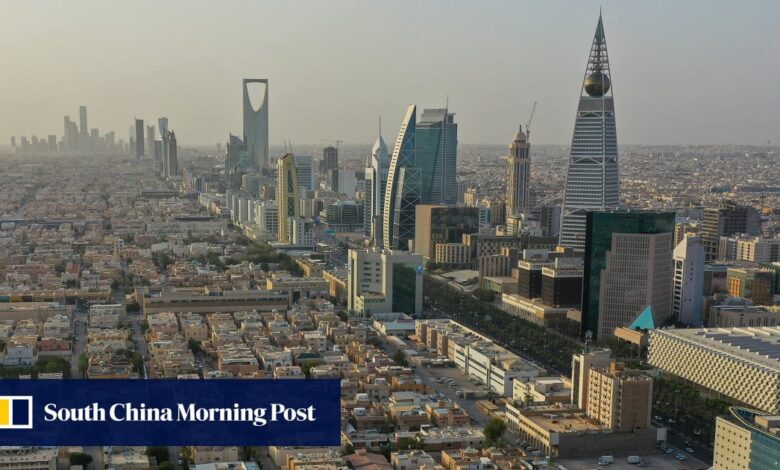Exclusive: Saudi central bank seeks regular dialogues, closer ties with monetary authorities of mainland China and Hong Kong to spur kingdom’s transformation

[ad_1]
Saudi Arabia’s central bank is seeking stronger ties with the monetary authorities of mainland China and Hong Kong, as the kingdom prepares to transition from an oil-dependent economy to one focused more on infrastructure development and attracting foreign capital.
The Saudi central bank is looking to strengthen its connections with the People’s Bank of China (PBOC) via bilateral dialogues, collaborations in multilateral forums, as well as partnerships in international organizations, said Ayman bin Mohammed Al-Sayari, the governor of the Saudi Arabian Monetary Authority (SAMA).
Bilateral dialogues can help the two nations foster mutual understanding by providing a platform to exchange “views, experiences, and policy insights,” the governor said in an emailed interview with South China Morning Post, calling on central bankers on both sides to engage in dialogues at various levels, including high-level meetings and working groups.
The governor said the two central banks can also engage in multilateral forums such as the Group of 20 nations (G20). “By adopting a collaborative and constructive approach in these forums, the two central banks can work together to address shared challenges and promote joint initiatives,” he said.
A “cooperative and consensus-driven approach” will allow Saudi Arabia and China to “advocate reforms and initiatives that address the needs of emerging and developing economies,” Al-Sayari said.
The governor also encouraged Chinese banks to grow and expand in Saudi Arabia, highlighting the importance of foreign investment and fintech-driven financial inclusion in promoting Saudi Vision 2030, a government programme aimed at reducing Saudi Arabia’s dependence on fossil fuels and diversifying its economy. Bank of China opened its first branch in Riyadh last month, the second Chinese lender to establish a presence in the kingdom.
“As of today, there are two branches of Chinese banks in Saudi Arabia, and we welcome this growth, and we will continue to support the financial sector, increase efficiency of transactions, and promote innovative financial solutions for financial inclusion,” the governor said.

As part of its effort to promote financial inclusion through fintech and digital banking, SAMA is also seeking more collaborations on digital assets.
“This will help to strengthen collaboration in several common areas, including fintech,” he said.

The remarks came as the global economy continued to see consumption-driven growth, while manufacturing remained sluggish. Meanwhile, inflation was falling slowly and steadily as a result of monetary tightening.
However, the IMF left its forecast for 2024 unchanged at 3 per cent. The growth forecast between 2023 and 2024 remained well below the annual average of 3.8 per cent seen in between 2000 and 2019, due to weaker manufacturing in advanced economies.

The outlook for emerging economies, on the other hand, was broadly stable, with growth of 4 per cent expected in 2023 and 4.1 per cent in 2024.
Saudi Arabia saw “robust economic growth” of 8.7 per cent in 2022, making it one of the fastest growing economies among G20 members, said the governor.
“Other economic fundamentals are strong, with inflation remaining low and stable at 2 per cent in August 2023, and with an average around 2.7 per cent since the beginning of 2023,” Al-Sayari said. “This is partly attributed to government policies such as energy price caps. In addition, the strength of the Saudi Riyal has helped mitigate the impact of imported inflation.”

More jobs are being created in Saudi Arabia. Unemployment dropped to 8.5 per cent in the first quarter from last year’s 9.4 per cent, due to substitution in the private sector, and as more women entered the work force after reforms in the kingdom’s labour and social policies. Women now make up 36 per cent of the Saudi labour force, surpassing the 30 per cent target laid out under the Saudi Vision 2030.
“The outlook for the economy in 2023 remains favourable, although a moderation in growth rates from recent highs is expected given recent changes in the oil and gas market and inflation is projected to be slightly higher than in 2022,” the governor said. “Recent independent forecasters, including the IMF, have stated that they expect strong investment rates to support strong non-oil GDP growth rates.”
A piece of cake? China-Saudi Arabia embrace ties, but it’s not all sweet success
A piece of cake? China-Saudi Arabia embrace ties, but it’s not all sweet success
Aside from attracting foreign capital and promoting financial inclusion, the Saudi Vision 2030 promotes infrastructure investment, tourism, the privatisation of state-owned companies, as well as investments into tech sectors.
The Public Investment Fund (PIF), one of the world’s largest sovereign wealth funds with total estimated assets of US$776 billion, is charged with executing projects under the Saudi Vision 2023, while the National Transformation Program (NTP) sets sector-specific strategic objectives and initiatives, with a focus on key areas like education, healthcare, and infrastructure, tracking progress across multiple sectors, according to the governor.
[ad_2]
Source link





